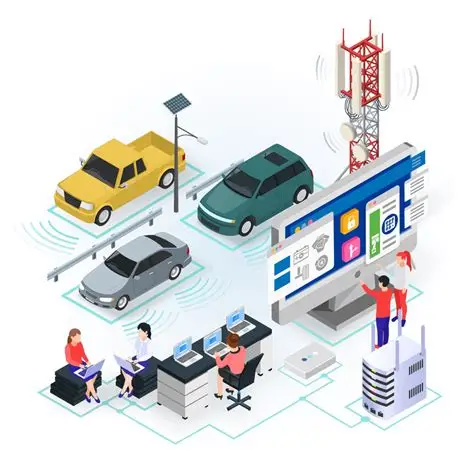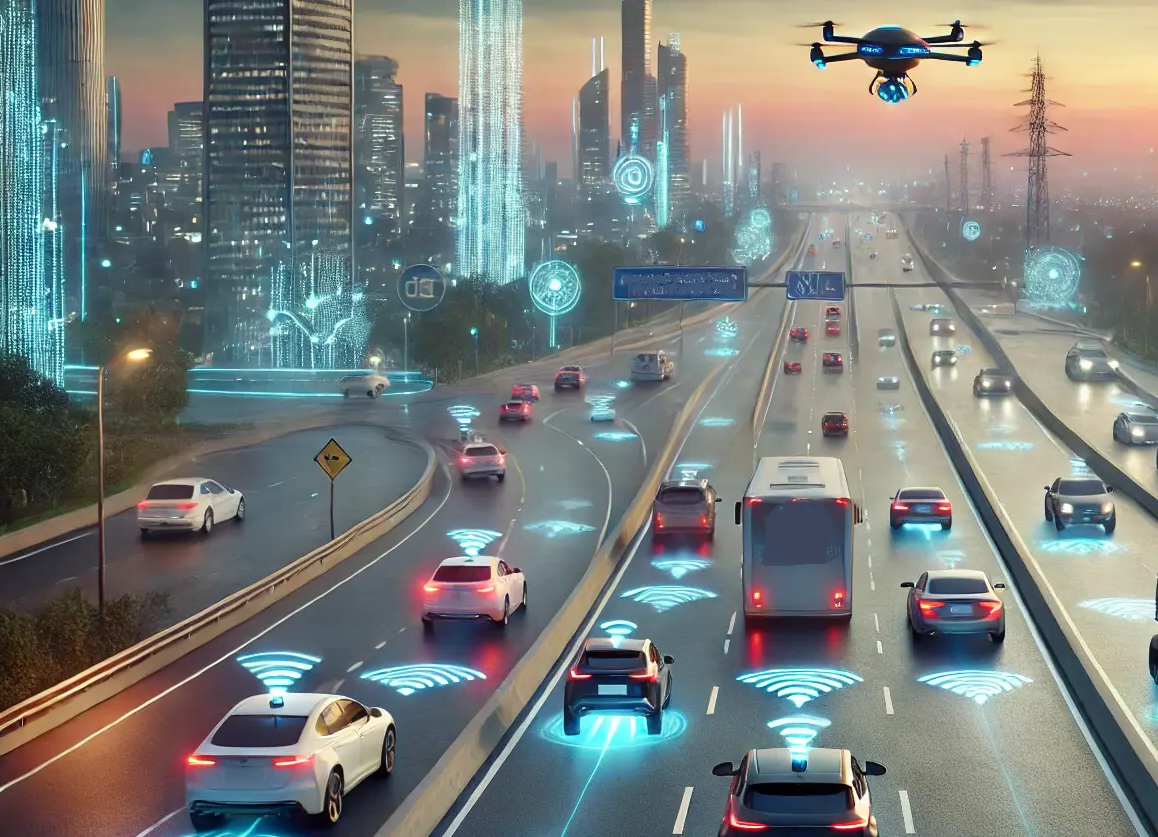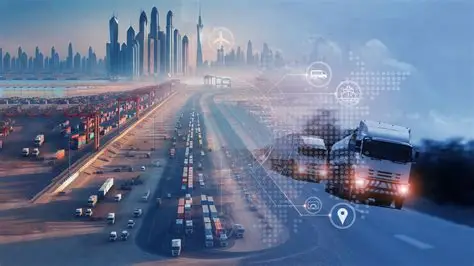Secure Fleet Data: Protect Operations with AI & Telematics
Aug 19, 2025 Resolute Dynamics
When managing a connected fleet, protecting your data is no longer optional—it’s mission-critical. Secure fleet data transmission ensures that your vehicles, drivers, and operations stay safe from cyber threats, avoid regulatory trouble, and operate at peak efficiency. Whether you’re running a logistics fleet in the UAE or managing smart mobility systems in India, this guide will walk you through exactly how to keep your fleet’s data safe and your operations smooth.
What Is Fleet Data and Why It’s So Valuable

Every time a vehicle in your fleet starts its engine, it generates data—lots of it. We’re talking about GPS location, fuel levels, engine diagnostics, driver behavior, braking patterns, speed, and even cabin camera feeds.
This kind of real-time telematics data is a goldmine. It helps you optimize routes, lower fuel costs, reduce wear and tear, and, most importantly, improve safety. But with great data comes great responsibility. If this information falls into the wrong hands or gets corrupted, the consequences can include stolen assets, compromised safety, or even legal trouble.
Top Threats to Fleet Data Security
Fleet data doesn’t stay still. It moves constantly—between vehicles, mobile apps, cloud servers, OEM platforms, and operations centers. This constant movement creates many chances for cybercriminals, system failures, or even insider misuse to break in and cause harm. If this data is stolen, altered, or blocked, it can lead to major safety issues, operational disruptions, and legal consequences.
Let’s break down the most dangerous threats fleets face today—and what makes them so serious.
1. Man-in-the-Middle (MITM) Attacks
This is one of the most common threats to vehicle communication. A MITM attack happens when a hacker secretly intercepts the data stream between the vehicle and the server—without either side knowing. Think of it like a fake post office worker who reads and rewrites your mail before it reaches you.
In fleets, this could mean:
-
Falsified GPS locations
-
Changed vehicle diagnostics
-
Modified driving behavior logs
Hackers use rogue access points, fake mobile towers, or compromised Wi-Fi networks to perform these attacks. Since many fleets rely on cellular networks, especially in remote areas, they’re often vulnerable unless encryption like TLS 1.3 or VPN tunneling is in place.
2. GPS Spoofing and Signal Manipulation
GPS spoofing is when a hacker sends false GPS signals to the fleet vehicle, tricking it into reporting a fake location. This isn’t sci-fi—it’s already happened in ports, high-risk zones, and even during international logistics.
The danger?
-
Drivers could be rerouted into unsafe zones.
-
Goods might appear “delivered” but never arrive.
-
Autonomous systems may make wrong decisions based on false geolocation.
Spoofing tools are getting cheaper and easier to find, which is why modern systems need anti-spoofing algorithms, multi-source navigation, and real-time anomaly detection to stay protected.
3. Telematics Device Tampering
Your telematics hardware—the “black boxes” inside the vehicles—are the brain and nervous system of your fleet. But if someone gains physical access to them, they can:
-
Clone the device
-
Install rogue firmware
-
Extract authentication keys
-
Bypass driver behavior tracking
Tampering often happens during servicing, in third-party garages, or even from insiders. Without hardware-level security (like tamper sensors or secure boot), it’s hard to know if a device has been compromised.
Common signs of tampering:
-
Gaps in vehicle logs
-
Irregular CAN bus traffic
-
Mismatch between physical and digital locations
4. Unsecured APIs and Software Integrations
Modern fleet systems aren’t just hardware. They run on dashboards, apps, third-party services, and cloud platforms. These systems talk to each other using APIs (Application Programming Interfaces).
If those APIs aren’t protected, attackers can:
-
Steal credentials
-
Inject malicious code
-
Gain admin-level access to your fleet’s data
-
Alter routes or disable safety systems
Common API flaws include:
-
Lack of authentication
-
Outdated endpoints
-
Overexposed permissions
This is especially dangerous for fleets using multiple integrations like fuel management, HR, insurance, or ERP software—all of which plug into the central telematics system.
5. Cross-Border Data Risks and Sovereignty Laws
Operating internationally? Then fleet data doesn’t just need protection—it needs legal compliance too. Different countries have strict rules about where data can be stored and how it must be handled.
For example:
-
UAE’s Personal Data Protection Law (PDPL) requires local data hosting for sensitive industries.
-
India’s Digital Personal Data Protection Act (DPDPA) mandates explicit consent and data minimization.
-
Europe’s GDPR imposes steep fines for unauthorized cross-border data transfers.
This creates a complex web of compliance responsibilities. Failure to comply—even unintentionally—could mean:
-
Fines in the millions
-
Loss of licenses
-
Forced shutdowns of regional operations
Fleet managers need to work with providers that offer data localization, regional cloud instances, and geo-fencing controls to stay within legal boundaries.
How Secure Telematics Keeps Your Fleet Safe

Telematics systems are the heart of connected fleets. But not all telematics platforms are built the same. A secure one uses end-to-end encryption, multi-layered authentication, and firewall-protected networks.
Here’s how advanced telematics protects your data:
-
Real-time data encryption keeps hackers from reading or modifying transmitted info.
-
Access control ensures only authorized users can see sensitive data.
-
Secure cloud storage prevents unauthorized physical access to data centers.
Platforms like those from Resolute Dynamics integrate these safety nets into their infrastructure. They don’t just track—they predict and protect.
AI-Powered Systems and Smart Control Modules

The future of fleet operations isn’t just connected—it’s intelligent. As commercial fleets evolve to meet rising demands for safety, efficiency, and automation, artificial intelligence (AI) has moved from an optional feature to a central pillar of modern fleet architecture. AI-powered systems and intelligent control modules are redefining how vehicles behave, how drivers interact with machines, and how operations centers make split-second decisions.
These aren’t just passive data collectors. They are active, autonomous systems capable of real-time risk detection, adaptive response, and predictive decision-making.
What Are AI-Powered Fleet Systems?
AI-powered fleet systems are built on a combination of software algorithms, onboard processors, edge computing units, and data inputs from a wide variety of sensors. These systems:
-
Sense the environment
-
Analyze patterns
-
Predict potential threats
-
Take automated or semi-automated actions
These aren’t just analytics tools. They form the core of autonomous vehicle behavior, enabling the vehicle to make smart, safe, and efficient decisions in real time.
Key Components of Intelligent Control Modules
-
Sensor Fusion Layer
AI systems rely on inputs from multiple sensors—each providing a different “sense” of the environment. These include:-
Cameras (visible and infrared)
-
Radar (for measuring object distance and speed)
-
Lidar (for creating 3D maps of surroundings)
-
Ultrasonic sensors (for parking and blind spot monitoring)
-
CAN Bus Data (vehicle internal signals: braking, throttle, steering)
Sensor fusion allows the AI system to combine these data streams and form a cohesive, accurate view of the vehicle’s environment and condition.
-
-
Edge AI Processors
These modules are installed directly in the vehicle (near or within the ECU) and process data locally in milliseconds. This enables:-
Real-time object detection and classification
-
Lane departure recognition
-
Driver fatigue detection
-
Emergency maneuver planning
-
-
Telematics Integration
AI modules work hand-in-hand with telematics units. While telematics provides macro-level data like GPS, engine diagnostics, and fleet-level communication, AI provides micro-level intelligence—such as determining whether a pedestrian is about to cross or a driver is distracted. -
Over-the-Air (OTA) Updates
Like smartphones, intelligent control modules can be updated remotely, allowing fleets to deploy new AI models, fix bugs, or enhance detection accuracy without taking vehicles out of service.
Real-Time Fleet Scenarios: AI in Action
Let’s look at a real-world example.
Scenario:
A fleet truck is driving on a highway. The driver suddenly slams the brakes.
Without AI:
-
The system logs the event for later review.
-
The operations team sees it after the fact, maybe hours later.
With AI-Powered Modules:
-
The system instantly detects “hard braking” and analyzes video footage from the cabin camera and front-facing camera.
-
It determines that the driver was distracted for 2.3 seconds before braking.
-
It sends a real-time alert to the control center, categorizing the event as high-risk.
-
The system even evaluates surrounding vehicles and automatically activates emergency hazard lights.
This is proactive risk management—not reactive reporting.
Behavioral Intelligence: Understanding the Human Driver
Modern AI systems aren’t only focused on road conditions—they’re watching the driver too.
-
Driver fatigue detection: AI tracks eyelid closure rate, head tilt, and blink speed using in-cabin vision systems.
-
Distraction monitoring: If the driver is looking down (at a phone) for more than 2 seconds, an alert is triggered.
-
Emotion recognition: Emerging systems detect anger, stress, or panic, which may influence driving decisions.
This combination of human and vehicle data makes the system not just smart—but empathetic in how it interacts with the driver.
Collision Avoidance and Autonomous Intervention
Perhaps the most powerful role of AI in fleet safety is predictive prevention. Rather than waiting for something to go wrong, intelligent control modules forecast potential incidents based on:
-
Speed trajectories
-
Proximity to other vehicles
-
Weather and road surface analysis
-
Past behavior of the driver
If a crash seems likely, the system can:
-
Issue escalating alerts
-
Adjust lane positioning
-
Activate emergency braking
-
Slow down acceleration
-
Or even override manual inputs momentarily (depending on vehicle level)
This is not theoretical—it’s already active in high-end logistics fleets and specialized defense vehicles.
Operational Benefits Beyond Safety
AI control modules don’t just improve safety—they deliver operational ROI as well:
-
Reduced insurance costs through AI-verified incident data
-
Lower maintenance needs by catching aggressive driving early
-
Fuel savings by optimizing driver behavior and vehicle response
-
Faster incident response times through real-time alerts
And in sectors like construction, defense, public transport, and hazardous goods transport, these systems are often essential to meet regulatory or tender requirements.
Integration with the Resolute Dynamics Ecosystem
Systems from companies like Resolute Dynamics are purpose-built to combine:
-
AI vision modules
-
Smart edge controllers
-
Real-time telematics platforms
-
Encrypted communication pipelines
This “Capture, Connect, Control” model ensures that data doesn’t just exist—it becomes actionable, secure intelligence. Their platform can trigger events, generate compliance reports, and even share alerts across the entire fleet network in under one second.
Data Compliance and Privacy Across Borders
If your fleet crosses international lines, you’re subject to various data privacy laws—like the UAE’s Personal Data Protection Law, India’s Digital Personal Data Protection Act, or Europe’s GDPR.
Failing to comply can mean fines, operational restrictions, or even having your fleet grounded.
To stay compliant:
-
Use geo-fencing to store data in specific regions.
-
Work with platforms that offer data localization features.
-
Audit your data flow regularly to ensure nothing is being transferred illegally.
Companies like Resolute Dynamics build their systems with global compliance in mind, offering tailored solutions for regions like MENA, Southeast Asia, and Africa.
Best Practices for Securing Fleet Data Transmission
Protecting your fleet’s data doesn’t require a massive IT department—just a smart plan and the right technology. Here are best practices:
-
Use encrypted data channels (SSL/TLS) for all communications.
-
Install tamper-proof telematics hardware in vehicles.
-
Set role-based access controls so only essential staff can view critical data.
-
Regularly update firmware and software to patch vulnerabilities.
-
Train your drivers and staff on cybersecurity basics—human error is often the weakest link.
Also, don’t forget to run frequent penetration tests and network audits to stay ahead of evolving threats.
Case Snapshot: Protecting a UAE-Based Logistics Fleet

A logistics company in the UAE operating across GCC borders integrated Resolute Dynamics’ platform. Before implementation, they faced frequent data breaches and inconsistent driver performance.
After deploying encrypted telematics units, AI-driven driver behavior analysis, and cross-border compliance tools, they:
-
Reduced safety incidents by 45%
-
Lowered unauthorized data access to zero
-
Improved fleet uptime by 30%
Their success shows the power of using a unified “Capture, Connect, Control” system to manage risk and performance in real time.
Future Trends: Smarter, Safer, More Secure
Fleet data security is entering a new phase—where vehicles talk to each other, to infrastructure (V2I), and even to pedestrians’ smartphones (V2P).
What’s coming next?
-
Blockchain for data integrity: Making fleet data tamper-proof.
-
Quantum encryption: The ultimate form of data security.
-
AI-driven anomaly detection: Systems that flag abnormal behavior before human operators can even react.
Fleets that adopt these cutting-edge technologies will lead the next era of safe, efficient transport.
Final Thoughts: Protecting What Moves Your Business
Fleet data is the lifeblood of your operations. If it’s not secure, neither is your business. With cyber threats growing and regulations tightening, now’s the time to get serious about secure data transmission.
Using advanced telematics, AI-powered control modules, and encrypted communication, you can create a secure, intelligent fleet—one that doesn’t just move cargo, but moves your business forward.